|
|
|
|
|
|
|
|
|
|
|
|
|
|
|
|
|
|
|
|
|
|
|
|
|
|
|
|
 |
|
After a busy but very COLD first winter spent at the old, dilapidated and freezing traditional Japanese wood-and-paper farmhouse we lived in until 2004, we finally finished building our first Waste Oil Heater the day before spring broke out. We had it in the kitchen, parts of which were open to the weather, and it really warmed the place up.
It burned petroleum fuels best, but we burned used cooking oil in it (WVO, waste vegetable oil), not used motor oil -- see Note. It produced a lot of heat, and smoked a little but not too much. but we found it needed decoking too often. (See Journey to Forever's forced-air biofuel heater.)
Like most things we build, it was made mostly from junk -- a 90-litre diesel fuel tank from a junked rice-drying machine, discarded stainless steel stove piping and fittings, a couple of frying pans, some scrap steel, some pieces of 1" water pipe, a length of 1/4" copper piping from a dead air-conditioner, nuts and bolts and self-tapping screws. Total cost was equivalent to about US$2.50.
See diagrams for design: Diagram A, Diagram B.
|
|
|
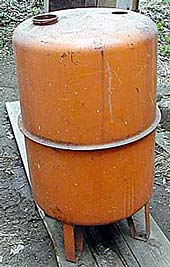 |
|
|
|
|
|
|
|
|
Right: The heater is fed from a 20-litre kerosene tank from a discarded water heater, on the shelf behind the bend in the stovepipe. It has an adjustable valve on the fuel outlet, necessary to get the fuel flow right.
Left: The 90-litre diesel fuel tank we made the heater from. |
|
|
|
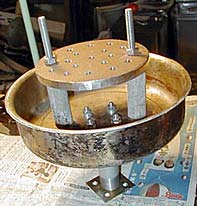 |
|
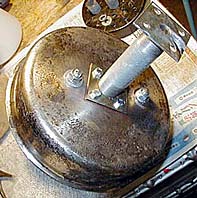 |
|
|
|
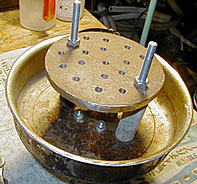 |
|
The base of the burner unit is an 8" stainless steel frying pan with the handle stub ground off and the rim cut back. It stands on two steel plates with a 4" length of 1" water pipe between them. The 3/8" round steel burner plate is just less than six inches across and is perforated with 5/16" holes. It's supported by two 3-1/4" lengths of 1" steel water pipe held by "redi-bolts". The top of the unit is an inverted 6" cast-iron skillet with the handle cut off, perforated with 5/16" holes. It's held above the burner plate by two 1" lengths of 1" steel water pipe. The whole unit bolts to the floor of the heater. |
|
|
|
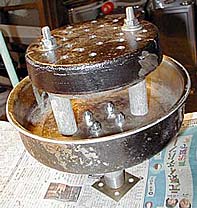 |
|
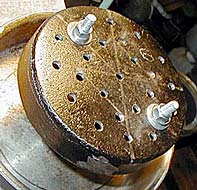 |
|
|
|
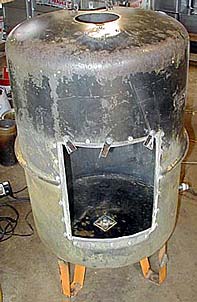 |
|
|
A door hole was cut in the tank and the cut-out used as the door. A steel backing is bolted in place inside the heater around the door space, its opening 3/8" less all round than the door space. Another piece of steel is bolted in place on the outside at the bottom edge to wedge the door in place. Three levers hold it in place at the top. A sliding viewing window is cut in the door. |
|
|
|
|
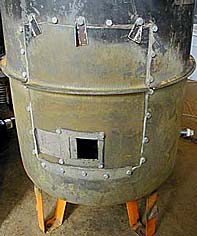 |
|
|
|
|
|
|
|
|
|
|
|
|
|
|
|
|
|
|
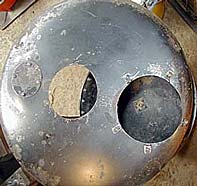 |
|
|
|
 |
|
|
|
|
A steel plate covers the filler cap hole, with holes cut for the 4" air pipe in the centre and the chimney. |
|
|
|
|
If you don't have a jigsaw that can cut steel, mark out the shape of the two big holes and carefully drill a circle of small holes next to each other just inside the circle. Cut through the metal between the holes, remove the inner bit of metal, and then use a half-round file to file the edges of the hole smooth until it fits the stove pipe. Clips and self-tapping screws hold the chimney in place. |
|
|
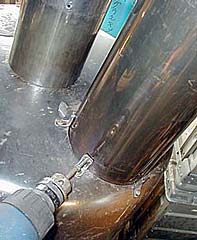 |
|
|
|
|
|
|
|
|
|
|
|
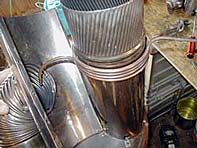 |
|
|
|
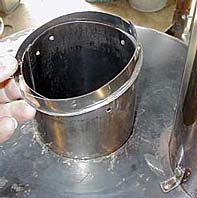 |
|
|
|
|
|
|
|
|
|
|
|
1/4" copper piping is wound four times round the chimney, inlet above, outlet below, with the outlet curved downward to drip into the air pipe. |
|
|
|
A ring cut from a length of stovepipe with a flange bent out at the bottom is screwed to the air pipe to hold it in position. |
|
|
|
|
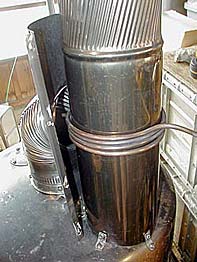 |
|
|
|
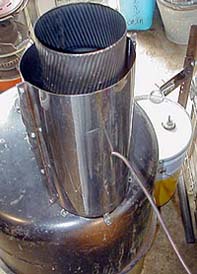 |
|
|
|
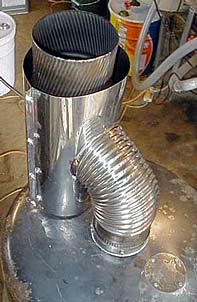 |
|
The fuel pipe in position, the front half of the sleeve screwed to the 90-degree bend on top of the air pipe. The inlet end goes through the back of the sleeve |
|
|
|
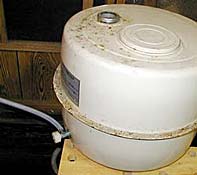 |
|
|
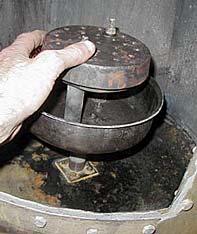 |
|
|
|
|
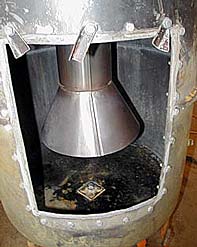 |
|
The fuel tank, above. Next, fitting the burner unit. Far right, the air pipe and flared funnel fitted down over the burner. How to build a funnel. |
|
|
|
|
|
 |
|
|
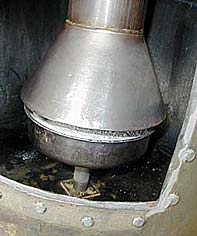 |
|
|
|
|
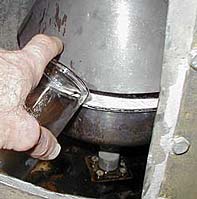 |
|
Raise the funnel (it slides up) to add perlite to the frying pan. Lower the funnel into place. Add a couple of hundred ml of kerosene to the perlite. |
|
|
 |
|
|
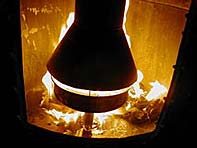 |
|
|
|
|
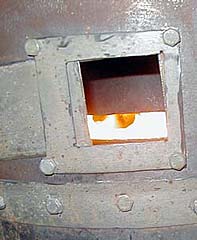 |
|
|
|
... and light the kerosene in the perlite. The burning paper sends hot air up the stovepipe and establishes the air-flow. Close the door, turn on the fuel supply. Check the blaze in the burner through the sliding window to adjust the fuel flow. |
|
|
|
|
|
Stuff some crumpled paper at the back of the stove on the floor and set it alight... |
|
|
|
|
|
|
 Roger Sanders' Waste Oil Heater
Roger Sanders' Waste Oil Heater Roger Sanders has updated his popular improved version of the Mother Earth News waste oil heater with a great deal of new information and options.
Roger Sanders has updated his popular improved version of the Mother Earth News waste oil heater with a great deal of new information and options.

























